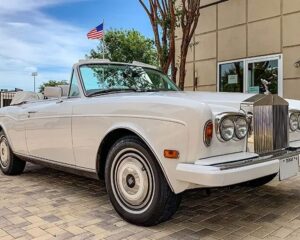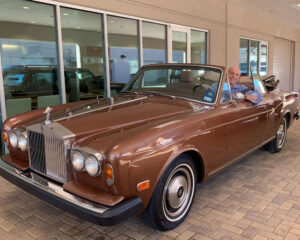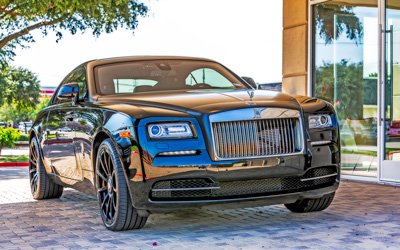Maintaining a Rolls-Royce is an experience as luxurious as owning the vehicle itself, but it comes with a price tag to match the car’s prestige. For those considering purchasing one of these iconic vehicles, it’s essential to understand the maintenance costs and their long-term implications. Unlike a typical car, owning a Rolls-Royce requires significant financial outlay even beyond the initial purchase, with specialized services, premium materials, and elite expertise contributing to the high expenses.
Routine Maintenance Costs
Rolls-Royce vehicles demand meticulous care to preserve their high standards of performance and aesthetics. A standard service, including an oil change, tire rotation, and system checks, generally costs between $3,000 and $4,000, depending on the specific model and service provider. This maintenance should be conducted every 7,000 miles or annually, depending on driving conditions and frequency. These routine services ensure that the car runs smoothly, but can escalate in price due to the exclusive nature of Rolls-Royce parts and the necessity of certified technicians.
For more extensive services, such as a 12,000 to 15,000-mile interval check (covering items like the braking system, battery, and fluid top-offs), owners can expect to pay upwards of $10,000. This thorough maintenance package often includes more in-depth diagnostics and repairs, which contribute to the higher cost.
Specialized Services for Rolls-Royces
One of the unique challenges of maintaining a Rolls-Royce is the need for specialized service providers. Rolls-Royce mandates that all maintenance and repairs be performed by certified technicians using only genuine parts. This exclusivity comes at a cost, as labor for a certified Rolls-Royce technician can range from $200 to $500 per hour. The complexity of the vehicle’s bespoke components further drives up the price.
For example, Rolls-Royce owners must replace the car’s brake pads every 30,000 to 40,000 miles, a service that can cost around $6,000 to $7,000. The vehicle’s air suspension system, which provides the famously smooth ride, requires servicing as well, typically costing around $5,000 for parts and labor.
Related: 2024 Rolls Royce Phantom EWB Diamond Edition
Cosmetic Maintenance
Rolls-Royce cars are known for their striking exteriors and opulent interiors. Keeping the car’s paint, leather, and other materials in pristine condition is vital to maintaining its value and appearance. Paint jobs on these vehicles are meticulously applied in a process that can take several days, with costs starting at around $15,000 for a professional repaint.
Moreover, regular detailing is necessary to maintain both the exterior and the cabin’s luxurious appointments. Detailing services can cost anywhere from $1,000 to $2,500 per session, depending on the level of care required. Leather seats, exotic wood trims, and delicate interior materials all demand frequent conditioning to prevent wear and tear. Full interior cleaning and conditioning can cost an additional $1,000 or more.
Tires and Other Consumables

In addition to tires, consumables such as brakes and fluids represent notable recurring expenses. Brake pad replacement, as previously mentioned, costs around $6,000 per set. Fluids such as oil, coolant, and transmission fluid, although cheaper than other components, require premium versions designed for luxury performance, adding to the overall cost.
How to Preserve the Value of a Rolls-Royce Over Time
Rolls-Royce cars are built to last, but preserving their value requires diligent care. To maintain the car’s high resale value, it is crucial to stick to the prescribed maintenance schedule, as skipping even minor services can hurt the car’s performance and lead to costly repairs. The use of genuine parts and authorized service centers ensures the vehicle’s integrity. Additionally, many owners invest in professional detailing and protective coatings to prevent paint damage from environmental factors. Keeping the car in a climate-controlled garage also helps preserve the interior and exterior materials.
Beyond routine maintenance, Rolls-Royce advises against any form of aftermarket modification. Maintaining the car’s factory settings ensures the integrity of its systems and its resale value.
What Insurance Costs Look Like for a Rolls-Royce
Insurance for a Rolls-Royce is much higher than for standard vehicles due to the value of the car and the cost of repairs. Comprehensive coverage is typically necessary to protect against theft, damage, and liability. Rolls-Royce owners can expect to pay between $10,000 and $30,000 annually for insurance, depending on the model, the driver’s record, and the geographical location. Insurers calculate premiums based on factors such as the rarity of the car, its high replacement costs, and the expense of original parts.
In addition, many insurance policies for high-end vehicles include coverage for rare parts, luxury rental vehicles, and agreed-value clauses to ensure the owner receives the car’s full value in the event of a total loss.
What Rolls-Royce Models Are Best for Long-Term Ownership
Certain Rolls-Royce models are more practical for long-term ownership than others. The Rolls-Royce Ghost is popular among owners looking for a slightly more understated but equally luxurious option. With advanced driver-assistance systems and an onboard diagnostic system, the Ghost is designed for both short urban drives and long-distance touring, making it a versatile choice for owners who wish to keep their cars for a longer period.
The Phantom is another top choice, often kept in immaculate condition for decades. Built with longevity in mind, this model is known for its robust engine and craftsmanship that ensures it can remain in excellent running order with proper care. For those who want a timeless, collectible vehicle, the Phantom holds its value exceptionally well.
Related: Why Rolls-Royce Cars Are So Expensive
How to Protect the Rolls-Royce Interior
The interiors of Rolls-Royce vehicles are some of the most luxurious in the automotive world, often featuring custom leather upholstery, handcrafted wood veneers, and unique materials like cashmere or exotic leather. Owners need to invest in regular leather conditioning to avoid drying and cracking. Professional detailing services that specialize in luxury interiors can help ensure that all materials, including wood and metal accents, remain in pristine condition.
For long-term preservation, many owners also choose to cover their seats when not in use and apply UV protectant films to windows to reduce sun damage to the interior.
How Often Should You Service a Rolls-Royce?
Rolls-Royce recommends annual servicing or every 7,000 miles, whichever comes first. This includes oil changes, tire rotations, and fluid top-offs. For models equipped with air suspensions, regular checks are necessary to prevent system failure. More intensive services, like brake pad replacement or suspension recalibration, are performed every 30,000 miles. Rolls-Royce’s Service Inclusive plan covers these scheduled maintenance tasks for a set period but is an additional cost after the factory warranty expires.
Additionally, the car’s onboard system monitors performance and alerts the driver when attention is needed, but the company stresses that regular inspections can prevent more costly breakdowns.
How to Safeguard a Rolls-Royce Against Theft

Many owners opt for insurance policies with clauses specifically addressing theft recovery, ensuring that if the vehicle is stolen, they’ll be compensated for the full market value or able to recover the car swiftly. Parking in safe, monitored locations is another essential strategy.
What Fuel Costs Can Rolls-Royce Owners Expect?
Fuel costs for a Rolls-Royce can be substantial, given the car’s size, engine, and weight. With many models averaging between 12-15 miles per gallon in city driving and around 20 MPG on the highway, owners of a Rolls-Royce Phantom or Ghost can expect to spend significantly more on fuel than the average car owner. For example, a Phantom could cost between $3,000 and $5,000 annually on fuel, depending on driving habits and fuel prices.
In urban environments or heavy traffic conditions, fuel consumption tends to be higher, so many Rolls-Royce owners prefer to use their vehicle for special occasions or long-distance travel, limiting city driving where the car’s luxury features are not fully utilized.
Warranty and Service Programs
Rolls-Royce offers a four-year, unlimited-mileage warranty for new cars, which covers most mechanical and electrical components. However, once this warranty expires, owners are responsible for all repairs. Rolls-Royce does offer extended service plans that can cover the cost of future maintenance, but these come at a premium. Extended warranties, which often cover five to six years, can cost anywhere from $15,000 to $25,000, depending on the terms and coverage level.
Long-Term Ownership Costs
For those planning to keep their Rolls-Royce for an extended period, the costs of ownership can add up significantly. Over a five-year period, it is estimated that a Rolls-Royce owner will spend about $75,000 to $150,000 on maintenance alone, depending on driving habits and the model of the car. This does not include insurance, fuel, or depreciation, which also contribute to the total cost of ownership.
Depreciation is another critical factor for Rolls-Royce owners. While these cars hold their value better than many other luxury vehicles, they still lose a substantial portion of their value over time. For example, a Rolls-Royce Phantom that costs $460,000 new can lose up to 30% of its value within the first five years, equating to a loss of around $140,000.
What Are the Best Driving Conditions for a Rolls-Royce?
While Rolls-Royce vehicles are engineered for performance and durability, they thrive under specific driving conditions that help preserve their luxury features. Ideally, a Rolls-Royce should be driven on smooth, well-paved roads that align with the car’s suspension design. Urban streets with potholes or rough terrain can accelerate wear and tear on the air suspension and tires, leading to more frequent servicing. Moreover, city driving with frequent stops and starts can result in higher fuel consumption and quicker wear on the braking system.
For those looking to minimize the maintenance costs, long-distance highway driving at moderate speeds is best. These conditions allow the engine to operate efficiently without unnecessary strain, and the air suspension delivers the signature smooth ride for which Rolls-Royce is famous. Additionally, it’s essential to avoid extreme weather conditions, particularly snow and ice, which can damage the car’s sensitive electronics and pristine exterior.
How to Properly Store a Rolls-Royce for Long-Term Protection
Storing a Rolls-Royce for extended periods, such as during winter or long vacations, requires careful planning to protect the vehicle’s mechanical and cosmetic integrity. To prevent battery drain, it’s advisable to use a battery tender or trickle charger, which maintains the battery’s charge without overloading the system. This is particularly important for Rolls-Royce vehicles, which have advanced electronic systems that can draw power even when the car is not in use.
Another critical consideration is the environment in which the car is stored. A climate-controlled garage is ideal for preventing temperature fluctuations that can damage both the exterior paint and the interior materials. High humidity can lead to rust on metal components and cause the leather to degrade over time. For extra protection, many owners use a high-quality car cover designed for luxury vehicles, ensuring it does not trap moisture or scratch the car’s surface
Regularly starting the car during long-term storage is also recommended. Allowing the engine to run for a few minutes every month keeps fluids circulating and prevents seals from drying out. However, it’s essential not to drive the car unless necessary, as sporadic short trips can lead to condensation in the engine and exhaust systems.
How to Maintain the Rolls-Royce Signature Paintwork
One of the most distinguishing features of a Rolls-Royce is its flawless, hand-polished paintwork. Maintaining this high-gloss finish requires specialized care. Rolls-Royce advises against using automated car washes, as the harsh chemicals and abrasive brushes can damage the paint and strip the protective wax layer. Instead, professional hand washing is preferred, using pH-balanced soaps and soft, microfiber cloths.
Polishing the vehicle regularly is essential for maintaining its luster, but this should be done with care. High-quality waxes or ceramic coatings offer an added layer of protection against contaminants like bird droppings, tree sap, and environmental pollutants. These coatings can also make it easier to clean the vehicle in the future, as dirt and grime will not adhere as easily to the surface.
For those living in regions with harsh climates, particularly areas with high UV exposure or acidic rain, an additional paint protection film (PPF) can be applied. This clear film shields the paint from scratches, chips, and other minor damages without altering the appearance of the car. Regular maintenance of this protective layer ensures that the paint retains its showroom-quality finish for years to come.
The Cost of Prestige
While the maintenance costs of a Rolls-Royce are undeniably high, they are a reflection of the brand’s commitment to excellence. Rolls-Royce cars are meticulously crafted, with each vehicle representing the pinnacle of automotive luxury. The attention to detail in both design and engineering means that every component is built to the highest standard, but this also means that the cost of maintaining such precision is equally steep.
For those who can afford it, the Rolls-Royce ownership experience is unmatched. However, prospective buyers should be prepared for ongoing expenses that match the vehicle’s initial price tag. Whether it’s routine maintenance, cosmetic care, or unscheduled repairs, owning a Rolls-Royce is a financial commitment as much as it is a lifestyle choice. The key is to plan for these costs and ensure that the car is serviced by certified professionals, ensuring that it remains in optimal condition for years to come.
Owning a Rolls-Royce goes beyond the initial investment. Maintenance, repairs, and the associated costs are all part of the experience, with owners typically spending between $25,000 and $30,000 annually to keep their car in top condition. For those who value craftsmanship and luxury, these costs are a small price to pay for the prestige of driving one of the world’s most iconic automobiles.

